
Traquair House, approximately 7 miles southeast of Peebles, is claimed to be the oldest continually inhabited house in Scotland. Whilst not strictly a castle, it is built in the style of a fortified mansion. It pre-dates the Scottish Baronial style of architecture, and may have been one of the influences on this style. The estate contains the famous Traquair Brewery.

George Heriot's School is a Scottish independent primary and secondary day school on Lauriston Place in the Old Town of Edinburgh, Scotland. In the early 21st century, it has more than 1600 pupils, 155 teaching staff, and 80 non-teaching staff. It was established in 1628 as George Heriot's Hospital, by bequest of the royal goldsmith George Heriot, and opened in 1659. It is governed by George Heriot's Trust, a Scottish charity.
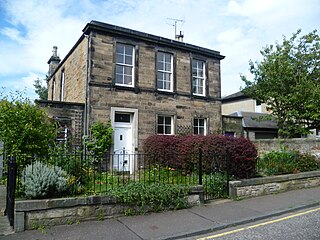
Sciennes is a district of Edinburgh, Scotland, situated approximately 2 kilometres south of the city centre. It is a mainly residential district, although it is also well-known as the site of the former Royal Hospital for Sick Children. Most of its housing stock consists of terraces of four-storey Victorian tenements. The district is popular with students, thanks to its proximity to the University of Edinburgh. Its early history is linked to the presence in the area of the 16th-century Convent of St Catherine of Scienna, from which the district derives its name.
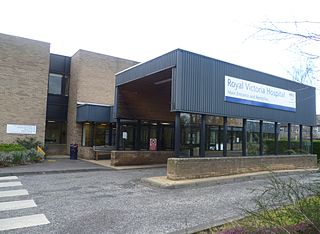
The Royal Victoria Hospital was a health facility at Craigleith Road in the north-west of Edinburgh, Scotland. It was formerly the main Medicine for the Older Adult assessment and rehabilitation hospital for the north of Edinburgh. It closed in 2012, then briefly reopened to ease pressure on acute beds in the region. The facility finally closed in early 2017 and was not in use when a fire caused damage to buildings in May 2017. It was managed by NHS Lothian.
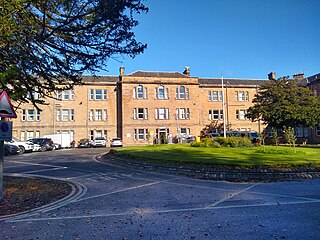
The Royal Edinburgh Hospital is a psychiatric hospital in Morningside Place, Edinburgh, Scotland. It is managed by NHS Lothian.

The Royal Infirmary of Edinburgh, or RIE, often known as the Edinburgh Royal Infirmary, or ERI, was established in 1729 and is the oldest voluntary hospital in Scotland. The new buildings of 1879 were claimed to be the largest voluntary hospital in the United Kingdom, and later on, the Empire. The hospital moved to a new 900 bed site in 2003 in Little France. It is the site of clinical medicine teaching as well as a teaching hospital for the University of Edinburgh Medical School. In 1960, the first successful kidney transplant performed in the UK was at this hospital. In 1964, the world's first coronary care unit was established at the hospital. It is the only site for liver, pancreas and pancreatic islet cell transplantation and one of two sites for kidney transplantation in Scotland. In 2012, the Emergency Department had 113,000 patient attendances, the highest number in Scotland. It is managed by NHS Lothian.

St Mary's Music School is a music school in Scotland in the West End of Edinburgh, for boys and girls aged 9 to 19 and is also the Choir School of St Mary's Episcopal Cathedral. The school, which is non-denominational, provides education for children with a special talent in music, and is Scotland's only full-time independent specialist music school. In 2017 the school has 80 pupils from many different backgrounds and from all parts of Scotland, the rest of the UK and abroad – 49 day pupils and 31 boarders, plus one student on the school's Part-time Pathways to Specialism scheme.

Broughton is an ancient feudal barony, today within the City of Edinburgh, Scotland.
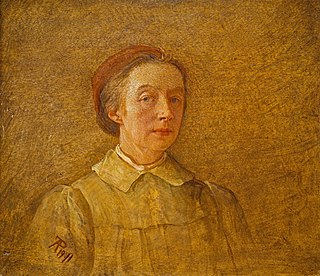
Phoebe Anna Traquair was an Irish-born artist, who achieved international recognition for her role in the Arts and Crafts movement in Scotland, as an illustrator, painter and embroiderer. Her works included large-scale murals, embroidery, enamel jewellery and book illuminations. In 1920, she was elected as an honorary member of the Royal Scottish Academy.

Ramsay Heatley Traquair FRSE FRS was a Scottish naturalist and palaeontologist who became a leading expert on fossil fish.
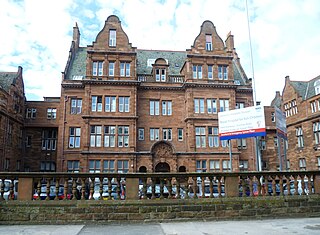
The Royal Hospital for Sick Children was a hospital in Edinburgh, Scotland, specialising in paediatric healthcare. Locally, it was commonly referred to simply as the "Sick Kids". The hospital provided emergency care for children from birth to their 13th birthday, including a specialist Accident and Emergency facility. Some in-patient specialties saw children up to their 16th birthday. The hospital was located on Sciennes Road in the Sciennes area of Edinburgh's South Side and was managed by NHS Lothian. It moved in 2021 to the new Royal Hospital for Children and Young People in Little France.

Sacred Heart, Edinburgh, formally known as the Catholic Church of the Sacred Heart of Jesus, is a Roman Catholic church run by the Society of Jesus, close to the city centre of Edinburgh, Scotland, United Kingdom. It is situated in Lauriston, midway between the Grassmarket and Tollcross, on the edge of Edinburgh’s historic Old Town. The church building was opened in 1860 and is a category A listed building.

Ramsay Traquair was a Scottish architect and academic with strong links to Canada. He is remembered more for his numerous publications than for his buildings, which are limited in number. He was a particular expert on Early Canadian and French-Canadian architecture.

John Miller Gray (1850-1894) was a Scottish art critic and the first curator of the Scottish National Portrait Gallery.

The Thistle Chapel, located in St Giles' Cathedral, Edinburgh, Scotland, is the chapel of the Order of the Thistle.

James Haig Ferguson LLD FRSE FRCPE FRCSEd was a prominent Scottish obstetrician and gynaecologist. He served as President of the Royal College of Surgeons of Edinburgh from 1929 to 1931 and was president of the Edinburgh Obstetrical Society. He chaired the Central Midwives Board of Scotland and was manager of Donaldson's School for the Deaf. In 1929 he was a founder member of the British College of Obstetricians and Gynaecologists.
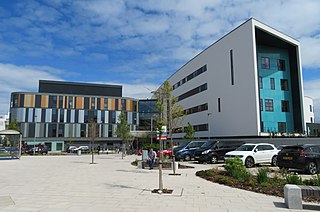
The Royal Hospital for Children and Young People is a hospital that specialises in paediatric healthcare. The hospital replaced the Royal Hospital for Sick Children in Sciennes. It forms part of the Royal Infirmary of Edinburgh campus in the Edinburgh BioQuarter at Little France, Edinburgh. The facility provides care for children and young people from birth to around 16 years of age and is managed by NHS Lothian.

Henry (Harry) Moss Traquair, FRSE, PRCSE was a Scottish ophthalmic surgeon who made important contributions to the science of perimetry and the use of visual field testing in the diagnosis of disease. He was President of the Royal College of Surgeons of Edinburgh in 1939/40 and President of the Ophthalmological Society of the United Kingdom.
Robert Thin PRCPE (1861–1941) was a 20th-century Scottish physician who served as President of the Royal College of Physicians of Edinburgh from 1931 to 1933, and was the first GP in this role.
Bellevue is a district of Edinburgh, the capital of Scotland. It lies to the south east of Canonmills, west of Leith Walk and south of Leith, incorporating the easternmost extent of Edinburgh's New Town UNESCO heritage site. The area was formerly open fields which became the second and penultimate location of the Royal Botanic Garden in 1763 .



































